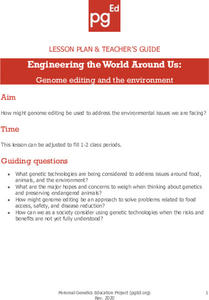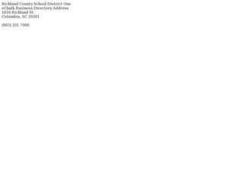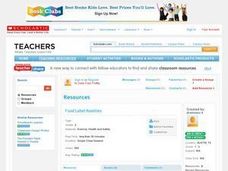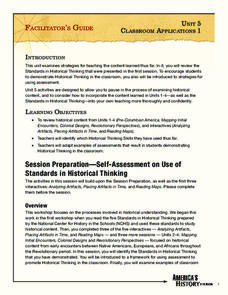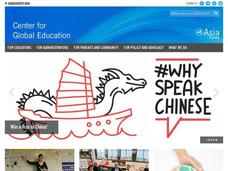EngageNY
Tracing and Evaluating Arguments: “The Future of Water” and The Big Thirst
Can scholars predict the future? They try as they first watch the video The Future of Water to capture details and trace the argument. Next, individuals complete the Tracing an Argument
note catcher to guide their thoughts. To...
Personal Genetics Education Project
Reproductive Genetic Testing: Technology, Access, and Decision Making
Explore the complexities of reproductive genetic testing respectfully in the learning space. Scientists read articles, view a slideshow, and complete a do-now about genetic technologies. A fishbowl activity allows scholars to discuss the...
Personal Genetics Education Project
Engineering the World Around Us: Genome Editing and the Environment
Challenge young minds to build a better world with genetic engineering. Biologists learn potential solutions for environmental issues using genome editing while interacting with three case studies. Scholars read articles and view...
Curated OER
Science Summaries are the Bomb!
Fifth graders read a dissection article and complete close reading activities for the text. In this reading skills lesson, 5th graders read an interactive frog dissection article in teams. Student teams complete a KWL chart and...
Curated OER
The Fog is Magic
Student increase their reading fluency through the use of various strategies. After reviewing good reader strategies, 3rd graders complete an initial read of a novel text. Working with a partner, they read complete a timed assessment of...
Curated OER
Writing Traits Instruction
Students assess and critique a wide variety of writing samples for each of the traits of writing strands from literature, composition writing, reading and assessment tools. They create and design a descriptive definition piece of writing...
Curated OER
Nutrition Unit
First graders complete activities for the six basic food groups. In this food groups instructional activity, 1st graders view examples of food samples from the various groups and sample the foods. Students discuss the food pyramid and...
Curated OER
Food Label Realities
Second graders identify nutritional information on food labels. In this nutrition lesson, 2nd graders bring in food labels from home and practice reading them. Students discuss the nutritional content, such as caloric content. Students...
Curated OER
Book Club Discussion: Things Fall Apart
Students read and discuss Chinua Achebe's novel Things Fall Apart. Students are guided to analyze the text through consideration of the author's use of 6 literary devices. Students also evaluate the text according to their personal...
Curated OER
Census Countdown
Students read and discuss the census and how the census is used by the government. In this census lesson plan, students use the data collected to compare different census's and their outcomes.
Curated OER
Student Viewing Guide: "The Alternative Fix"
Young scholars discuss the merits of and problems with alternative medicines after watching a documentary entitled "The Alternative Fix." They discuss the documentary after completing the viewing guides.
Curated OER
Anticipatory Set Picture Walk
The teacher models a Picture Walk by using a "think aloud" method while reading a picture book to the class. On the second day, 3rd graders use a worksheet as a guide for a second picture walk. This time, students complete the "think...
Curated OER
Laurence Yep's Dragonwings
Students read independently the novel, "Dragonwings," by Laurence Yep and make connections between a text and the world. They summarize, paraphrase, analyze and evaluate skimming and scanning techniques when reading a novel. Each student...
Annenberg Foundation
America's History in the Making: Classroom Applications One
Someone finds a time capsule 100 years from now, and it includes your family photo album. What would the photos tell that person about you and your place in history? Scholars investigate how artifacts tell stories. Using photos, maps,...
Annenberg Foundation
Postwar Tension and Triumph
Go get the American Dream lifestyle! The 19th lesson in a 22-part series exploring American history shows learners the post-WWII economic boom. Using primary sources, photographs, and cartoons, groups discuss their findings and present...
Annenberg Foundation
Egalitarian America
What does a true American represent? Scholars investigate the equal rights era of the 1960s and 1970s in the 20th installment of a 22-part series on American history. Using photographic, magazine, written, and video evidence, groups...
Curated OER
Inspector Readers: The 002 Book Club
This unit introduces book clubs/literature circles to lower elementary classes, but could be adapted to higher grades. It outlines the anticipatory activity that includes a WebQuest, a discussion to clarify questions about the unit,...
Curated OER
Who is the Expert? Exploring Credible Sources in Healthcare
How do you decide what sources are credible when researching online? Evaluate sources with a focus on researching health issues. After brainstorming common health concerns and how they would try to diagnose these problems, class members...
Curated OER
Note-Taking: K.I.S.S. "Keep It Short and Simple"
Note-taking is an essential study skill, and it needs to be taught! In the context of a research project on energy sources, learners find multiple sources, evaluating, paraphrasing, and citing them correctly. Two lists with note-taking...
Curated OER
Fever 1793: Round Table Discussion
All things considered, it will be a good day for readers as they manage on their own to develop questions about what intrigues, bothers, or confuses them in Laurie Halse Anderson's tale of Mattie Cook and the Yellow Fever epidemic...
Curated OER
Geography and Culture of China
Take out a map, a paper, a ruler, and those coveted colored pencils for a lesson on Chinese culture and geography. This is a multifaceted approach to basic geography skills that incorporate story telling, class discussion, primary source...
Annenberg Foundation
America's History in the Making: Classroom Applications Three
How can primary sources bring history to life? Scholars create detailed lesson plans on the late nineteenth and early twentieth centuries in American history. The 17th installment of a 22-part program exploring American history examines...
K12 Reader
Churchill's Speech: We Shall Fight on the Beaches
Winston Churchill speech delivered to the House of Commons on June 4, 1940, is the focus of a comprehension exercise that asks readers to explain how the repetition in the speech supports the main purpose of Churchill's address.
K12 Reader
Hide and Seek
After examining a brief article about survival adaptations, readers identify the main idea of the passage and list two supporting details.




